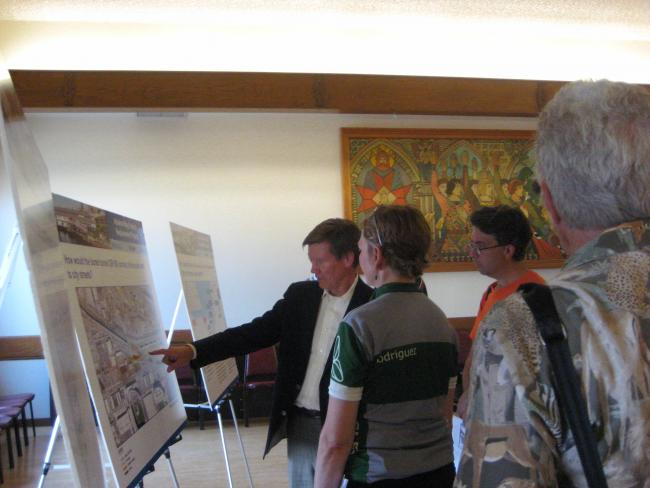Bored tunnel plans confuse, concern Ballard residents
Ron Paananen, Alaskan Way Viaduct and Seawall Replacement Program administrator, explains to residents the access to city streets with the planned bored tunnel.
Fri, 06/12/2009
Two portal designs were presented at a public meeting last night, June 11, showing how a bored tunnel, which is planned to replace the aged-Alaskan Way Viaduct, would connect with city streets for northbound and southbound traffic.
Some community members were still at a loss on how the design worked and expressed concern about the possible congestion it could cause for north and southbound drivers, as well as the planned four-lane waterfront boulevard along Alaskan Way.
“We’re beginning the second supplemental draft of the EIS (environmental impact statement) that will evaluate the bored tunnel,” said Amy Grotefendt, a spokesperson for the Alaskan Way Viaduct and Sewall Replacement Program said. “We’re out here tonight asking people to give us comments on what issues should be analyzed in the EIS now that we have the portal designs and know how access into and out of the tunnel will work.”
Mark Bandy, transportation planner for Washington State Department of Transportation, said the initial plan is this: If someone were driving through the tunnel northbound there would be an exit and off ramp to Republican Street. The exit would then lead to Dexter Avenue and there would be an option to turn left up to Mercer Street, another left onto Mercer Street and head west down the hill.
“If you’re going to Ballard, you could take the same route or take the tunnel and run into Aurora and go up the 39th bridge way exit or 46th depending on where your destination is during the day,” Bandy said.
Some residents and business owners were concerned how traffic will flow along the new four-lane waterfront after the tunnel is built.
“If they make the tunnel too difficult to get to and get off of, especially in the Northwest quadrant, Ballard, Queen Anne and Magnolia, it makes it difficult to use that corridor,” said Warren Aakervik, owner of Ballard Oil. “They’ll (drivers) will all go to the waterfront and the question is how many vehicles will be on the waterfront, and how much congestion will it cause.”
Richard Min of Aurora Avenue Merchants Association said he felt the new maps of the portals were lacking in design.
“There’s not enough detail,” he said. “It’s not clear what it is becuase each concept has different exits and entrances it’s very confusing. The design is not there and going ahead with a full EIS with a preliminary design, they’re marching forward without a design and it doesn’t make sense.
The city and state said that they will be studying three key parts in the second supplemental draft of the EIS, including a detailed analysis of the bored tunnel construction, removal of the existing viaduct and closure of the Battery Street Tunnel.
They will briefly review other program elements as they relate to the viaduct replacement, such as the new waterfront promenade, the new Alaskan Way surface street design and construction, seawall replacement, various street improvements, First Avenue Streetcar and enhanced transit service.
Lastly, several improvements will be completed before it opens to traffic. These projects include, East Marginal Way grade separation, Spokane Street Viaduct widening, SR 519, South Holgate and South King viaduct replacement, and two-way Mercer Street from Dexter Avenue to I-5.


